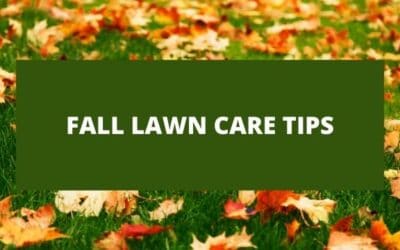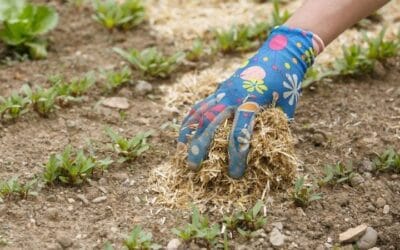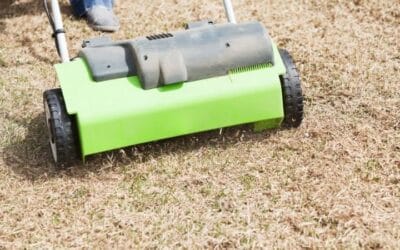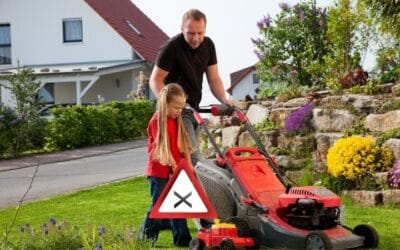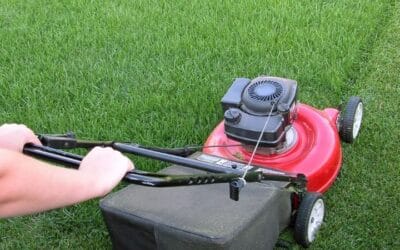Spring Lawn Preparation | Easy Step By Step Guide
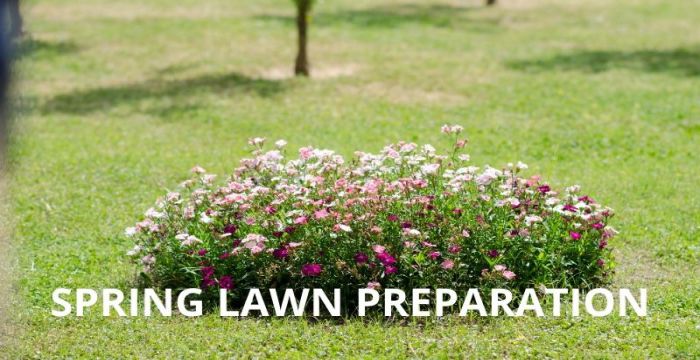
“Speak of spring, the foison of the year,” goes a famous quote. Spring follows winter, precedes summer, and is the first season of the year. Trees come into blossom, and plants spring forth from the ground and life sprouts from all around. It is the time when your lawn, just like all other plants, is reproducing and putting on its very best coat.
In order to give your lawn, the best look of the year, adequate spring lawn preparation is required. When done right, preparation guarantees a lush green, fully patched, and perfect lawn thought the spring season. This article will take you through the recommended steps and expert advice that will undoubtedly give you the best results.
Step 1 – Clean up
To start spring lawn preparation, It is important to clean up the dry dirt that has accumulated in the fall season. You need to get anything that will disturb your lawn growth out of the way. Leaves, twigs, rubbish, and rubble are some of the things that can hinder or disrupt proper lawn growth. Spring follows winter, a season when lawn grass blades die. Dead grass blades are dirt on your lawn. With time, they turn into thatch, which is an even bigger problem, so you must clean up the dead blades.
You may also find litter on your lawn. Garbage such as paper and plastics need picking off the lawn. Not only does such dirt look terrible on your lawn, but it also disturbs proper and healthy growth. Stones or debris can be stuck in your mower. The rubbish will prevent water, weed, and feed from penetrating the soil. So cleaning can never be overemphasized; it needs to be done.
A well-done job calls for the right tools. Use a rake to clean away any dirt that lies on the grass. It will pull away any leaves, twigs, air cones, or light rabble off the lawn. Be sure to have your rake in good shape to work on your lawn in preparation for spring. Alternatively, an air blower will do an even better job. It is a mechanical form of a rake. It is more efficient and more comfortable to use. It works by using air to blow away dirt from the grass. You can handpick large rocks or debris off the lawn first before raking.
Remove thatch
Even with no twigs or leaves, you still need to rake off thatch. Thatch lies deep inside your lawn between the grasses. It is a layer of dead or living turfgrass. Raking also solves snow mold, a disease characterized by grass blades bonded together, making it difficult for new grass to infiltrate. When thatch thickens to half an inch or more, it suffocates your lawn. Therefore, you need to rake deeply, or air blow your lawn to get rid of any thatch. When your lawn is clean, you are ready to go.
Step 2 – Aerate your lawn
All the sitting, running, and playing on the lawn will eventually compact the soil. Aerating ensures an adequate supply of air into the soil. Good soil must have air spaces. It is hard for grass to grow through compacted soil, thus the need to aerate. A sure sign that your soil is compacted is moss. It only thrives on hard places like stones or compacted soil.
Aerating the lawn will create openings that allow water and air to penetrate the soil and allow new grass to grow. Buying a lawn aerator is an option, but it is quite expensive. Instead, you can either use a hand aerator on your lawn. Aerate using a hand pick or aerating shoes. Vertically push down a pick through the grass to aerate it. You can alternatively hire a lawn aerator at a nearby hardware or garden center. Follow a guide on how to use it and aerate your lawn for good healthy growth.
The soil also should not be too wet to aerate your lawn successfully. Therefore, check by pushing a garden fork through the soil. If the fork comes out with soil stuck on it, it is too wet to aerate. You will also need to wait a little while for the soil to dry up. Be aware that aerating also gives room for weeds to grow. The holes created during aeration provide the best places for weeds to germinate. Therefore, apply weed and feed soon after aerating to kill all the weeds before they sprout out.
Step 3 – Soil testing
The optimal pH for lawn grass is neutral. Highly acidic or alkaline conditions are not conducive to a healthy lawn. A good indicator that your soil is acidic is moss. Send a sample of your soil to your local cooperative extension office. There, you will have your sample sent to a laboratory and analyzed to determine your soil pH level. You will then be advised on how much lime per square feet you need to add to neutralize your soil.
Use a fertilizer spreader to spread ground limestone accordingly. The lime will penetrate and work gradually over the season. Do not add too much lime as it will make the soil alkaline, and that is undesirable.
Step 4 – Overseed or reseed your lawn
Overseeding is a process whereby you apply seed over already grown grass to fill in bare patches. These bare patches result from human or animal traffic. They rob you of the thick lavish lawn you want to see during the spring season. Before overseeding, you need to discover the problem causing the thinning or patches in the first place. Test the soil on the patches to make sure it has the optimum of a neutral pH. Aerate and moisture the area.
Choose a top-quality grass seed to reseed the lawn, one that can thrive even in high traffic spots. You can hand drop the seeds or use a drop or broadcast spreader for larger areas. You can simply spread the grass seed over the area with patches or where you feel the grass is too thin and needs filling. Often as grass matures, it thins down. Overseeding is a process you are sure to attain results from if done right. For the seeds to germinate well, fertilize using a slow-release nitrogen fertilizer.
Step 5 – Apply fertilizer
Fertilizer is one top secret to a perfect lush green lawn. And it is a good source of supplementary nutrients for your lawn. A feed is best applied as you approach spring when the lawn is growing. It is an excellent cause for a healthy lawn. Common chemical feeds provide nitrogen, phosphorus, and potassium in different proportions. For best results, get a sample of your soil tested and recommend the best feed to add to your soil. Compost is an excellent organic fertilizer for your lawn.
Fertilizers came classified as either slow-release or high-release fertilizers. The classification is according to the rate at which the fertilizer releases nitrogen. A slow-release fertilizer is applied when the grass is still young or just after overseeding your lawn. As time progresses and the grass mature, you can now apply a high-release fertilizer. As you prepare for spring, fertilize your lawn only lightly to avoid weed problems. Be assured not to overlook the importance of this stage. Fertilizer is vital. See this article on when to fertilize lawn.
Apply pre-emergent weed killer
As much as your lawn gets excited about spring, so do weeds, and they are bad news. They compete with your lawn for nutrients, water, and even steal attention. For a healthy lawn, you need to prevent weeds from emerging at all by using a pre-emergent weed killer. The perfect remedy for weeds is a herbicide. Pre-emergent weed killers kill the weed before it sprouts on the surface. They come as either granular or liquid weed killers, each being just as good as the other. However, in its liquid form, the pre-emergent weed killer works much faster.
Crabgrass is a common weed that usually appears annually in the spring season. Such stubborn weeds are difficult to get rid of after germinating. The best solution is a pre-emergent weed killer because it coats the seed and forms a protective barrier over the soil to prevent it from germinating. An important point to note is that the application of pre-emergent weed killers must succeed aeration. This is because core aerating will puncture holes in the groundbreaking protective barrier formed by the herbicide. So for maximum effectiveness of the pre-emergent herbicide, do not aerate after application.
However, experts strongly advise against the use of pre-emergent weed killers after overseeding. The herbicide will affect the growth of the new lawn. However, if you need to do both, use a pre-emergent weed killer called Tenacity; it is overseeding friendly. The weed killer remains active in the soil for a period of six to eight weeks. Hence, you may need to reapply later as the spring season progresses.
Apply post-emergent weed killer
A post-emergent weed killer is necessary when is your lawn already has weeds as you prepare for spring. A post-emergent weed killer will only work on weeds that have germinated. Scout your lawn for weeds and if you spot any weeds. A post-emergent herbicide is a sure remedy for these. Within just a few days, you will even notice the weeds wither, discolor, and die. Note that post-emergent weed killers only work on growing grass; therefore, apply it before a while mowing.
Hand pull weeds
A chemical-free way of getting rid of weeds is by pulling them out. Some weeds are very stubborn and will need more than one weed killer application to get rid of. For such weeds, a quick, easy, and cost-efficient solution is to pluck them out by hand.
Step 6 – Prepare your mower
A lawnmower needs to take care of before spring begins. During this season, the lawn grows fast and requires frequent cutting, so a breakdown should be the least of your worries. Service the lawnmower as you get ready for spring. Sharpen your mower blades. Over time, hitting hard surfaces and rocks will make your mower blades blunt. Only sharp blades will give you a perfect healthy cut. You should also check the tires and repair any flat tires. Clean the deck and filters of your mower. Check out to see if it is necessary to change the oil in your mower. If you are using a new lawnmower, it is essential to read the user manual before starting it.
Makes sure you have the correct fuel for your mower to avoid breakdown. A mower in bad shape may require professional service, or it may call for you to purchase a new one before spring begins. After or before using it, you need to store your mower correctly, make sure that the area you keep it in is a clean, dry, and cool place. A garage is a good storage location. You can also keep it covered in a trailer or any other dry place. Outdoors, in a moist environment, your mower will wear, build up rust, or corrode.
Step 7 – Mow your lawn
For some, lawn mowing may seem tedious, but be sure not to skip it during spring lawn preparation. Give your lawn a neat, clean-cut before the spring season begins. Make sure you kick-start the peak growing season with a well-cut lawn to avoid overgrowing it. Cutting your grass after it has already grown too high will stunt the development of its root system. This makes it difficult for the lawn to reproduce. It is highly recommended that you mow your grass before it is any longer than 3¾ inches.
No matter how big it grows, you should never remove or cut down more than a third of the grass at once in a single mow. Removing a third at 3¾ inches will leave your grass at the optimum height of 2½ inches. Mowing also helps thicken your grass. This is because the hormones in the grass blades’ tips keep them growing vertically but suppresses horizontal growth. Therefore, cutting your grass will help it to grow thicker and better. As the spring season progresses, you will need to mow your lawn every six to seven days regularly. Make sure it does not overgrow. Please do not cut your lawn when it is dry.
Step 8 – Trimming
Trimming is cutting off dead branches and twigs from trees and shrubs. Trimming is done not only to shape your trees and shrubs but also to cut down falling branches. Dropping branches may cause injuries to people, damages to property, and even your lawn. As you prepare for spring, look around, climb into trees, and chop down dead branches. Remove crossing branches that grow back towards the tree. Pruning down trees will also give your lawn area a beautiful neat spring look. Taller trees may need professional trimming services. Hire a tree trimmer to prune your trees once in three to five years to get rid of bigger branches.
Step 9 – Watering your lawn
When transitioning from winter to spring, the soil is still yet to warm up. For survival, any lawn needs watering. However, be careful not to overwater the lawn, especially after applying weed and feed to it. So, before watering, barrow a finger into the soil and observe water only when the soil inside is dry. To obtain the best results, water early in the morning before it gets warm. Also, consider watering only the dry parts of the lawn. Sure signs you need to water your lawn
- Withering blades at daytime
- Lawnmower prints long after mowing
- An off-green color maybe a brown or blue-grey color.
- If you live in an area where water supply is limited, water your lawn 12 centimetres deep to sustain the grass for a while.
Step 10 – Mulch
Mulch is a layer of matter that covers the topsoil. Mulch protects, insulates heat, retains moisture, and discourages weed growth. It improves the soil’s texture and composition, thus aiding the growth of a healthy green lawn. Heavy mulch is ideal in preparation for spring. Good examples of heavy mulches are ground chips or hardwood bark mulches. And an efficient source of mulch is formed dead branches on shrubs around. Therefore trim these down to get a perfect and effective mulch.
Mulching lawnmowers
A mulching mower is a very efficient and handy tool. It mows and mulches grass simultaneously. Finely chopping the grass and mulching it back on the grass. Mulched grass clippings release nitrogen and other nutrients back into the grass to benefit and fertilize the remaining grass. The mulching grass will also remove moisture into the grass, helping to keep it greener and healthier.
Final verdict
These ten easy steps can turn any hopeless winter-stricken lawn into a gorgeous green admirable lawn. The spring season breathes new life into all that is around. Allow it to work drastic wonders on your lawn by using this guide for great tips on spring lawn preparation.
Spring is a season that naturally adds beauty to your lawn. And preparation, before the season begins, will assure you an even better spring season. Carefully follow the steps and instructions alluded above to usher your lawn into the best spring season ever. Spring lawn preparation guarantees a lush, vibrant green lawn that will blow away any onlooker’s mind.

Kazi Taslim
Editor
Poweredgrip ensures that an expert team of writers provides you with excellent, unbiased informational content. We are dedicated to giving you the most up-to-date and smoothest information possible. We share incomparable tips and tricks that give you awareness and confidence when making your buying decisions. Our team is enthusiastic, dedicated, and hardworking. Kazi Taslim is the editor and head of our experienced writing team.
Related Post
Fall Lawn Care | Essential Fall Lawn Care Tips
Fall has come with its cool weather, and you do not know how to maintain your lawn to be healthy and strong. You really want to improve your landscape's appearance, and having a lush lawn all year round is your goal. If that is the case, you do not have to worry. Fall...
Benefits of Mulching | Tips on Mulching Grass Clippings
When starting to cultivate your interest in gardening, you will constantly be looking for ways to improve your plants. You could be curious if getting dirty from handling the mulch is worth it. Well, you have searched in the right place at the right time as well. In...
Winter Lawn Care | Basic Tips of Winter Lawn Care
Winter is characterized by extreme weather conditions that can stress your lawn, making winter lawn care important. Cold and dry spells are likely to reduce the growth rate of your lawn. Most grasses enter dormancy during this cold season. Also, to make matters worse,...
Best Time to Dethatch Lawn | Lawn Dethatching Tips
We all see lawns in parks or around buildings such as a house, office, apartments, or commercial premises. Gardens provide an enticing look, and people keep and maintain lawns for the scenic or recreational feel. However, this beautiful green requires a lot of work...
Lawn Mowing Safety Tips | To Know Before You Mow
Mowing your lawn is one of those "macho" chores that are generally regarded as masculine. The whole idea of crank starting the mower's petrol engine and getting all sweaty pulling and pushing it forth makes one feel invincible. "What could really go wrong?" you might...
When to Start Mowing Lawn | The First Cut of The Year
Lawn mowing is not an event confined to a specific calendar date. Instead, you should monitor your grass length and mow only when necessary. Every homeowner or gardener needs to know when to start mowing lawn to maintain a clean and neat grass cut. This article will...

